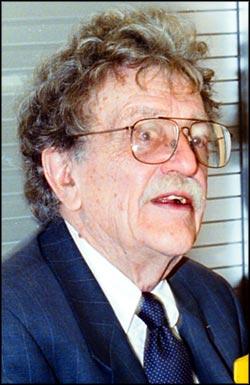 |
 |
| Dresden Bombing By Catherine Williams The Pulteney St. Survey [Hobart and William Smith Alumni Magazine] Spring 2001 Pages 20-21 http://www.hws.edu/alumni/keepintouch/pssurvey/spr01_dresden.asp On a cold winter night in February, 1945, a group of Allied prisoners was hustled into a subterranean slaughterhouse refrigerator in the bowels of Dresden, Germany. It was World War II and the city was about to be decimated by a one-two punch of Allied bombs and incendiaries that would result in a firestorm of monumental destruction. Shuffling toward that airtight prison, an unusual but effective air-raid shelter, were 150 POWs, including Gifford Doxsee '46, a future Harvard-educated historian; Kurt Vonnegut, who would go on to write one of the most powerful anti-war novels in American history-Slaughterhouse-Five; and Edward Reginald "Joe" Crone Jr. '45, a Hobart student who was the inspiration for Vonnegut's book. "We were a peculiar glitch in American military history." Vonnegut explains. "We were all college kids. Look at Doxsee going on and getting a Ph.D. and my friend [Bernard V.] O'Hare. He became a DA and then went on to become a famous criminal lawyer. I went to Cornell and I was a big shot there. We were college kids. But what they needed were bodies on the front line. My division, the 106th, was completely wiped out [in the Battle of the Bulge]. We were sent there to just fight and I have to say we were pretty good soldiers." Captured by Germans during the Battle of the Bulge, Doxsee, Vonnegut, and Crone were among the thousands of Allied troops marched in the bitter cold for three days to Gerolsteain, Germany, where they were packed in freight cars and transported for eight and one-half days, with little food or water and through a bombing in the city of Limburg, to a prison camp in Muhlberg. On January 12, as part of a work group, Doxsee, Vonnegut, Crone, and some 150 other prisoners of war were transported to Dresden. By the time they reached Dresden, the men were starving and exhausted. They were housed in a concrete compound of buildings originally built to slaughter livestock. The Germans called it Schlachthof Funf, or "Slaughterhouse Five." For two months, the slaughterhouse POWs worked as slave laborers for German businesses. "We didn't know what to do," Vonnegut says. "We were a long way from home as I might say a lot of American soldiers are. I spoke some German and I was made head of the Arbeitskommando. It was a matter of election. I tried my best to make things better for the troops. I was in charge of the Americans to the extent that I could be." It was in Dresden that Vonnegut noticed Crone. "I was a battalion scout so I didn't know Joe until we were prisoners. He might have even been a Chaplain' s assistant. At any rate, he was religious. It must have really been strange for him since the Germans were Christians." In his application to Hobart College, Crone wrote that he had a five-year perfect attendance at St. Paul's Episcopal Sunday School in Rochester, N.Y. and that he wanted to become an Episcopal minister. His college friend Willard Moody '45 remembers that Crone was, ".good-natured and a caring person. He was easy-going and always tried to help others." His high school assistant principle wrote that Crone was "possessed of moral courage," but that he was also physically "awkward." Crone's acquaintances from high school remember him as being somewhat unmemorable, an observation that Vonnegut gruffly denies: "Well, to me, he was beautiful. The people who would say that are the ones who like quarterbacks and cheerleaders. Joe didn 't understand the war and of course there was nothing to understand. The world had gone completely mad." Doxsee recalls that the night of the firebombing, guards woke the POWs after midnight and marched them from their normal housing to an underground storage house. Sheltered from the bombing, Doxsee, along with fellow POWs Vonnegut and Crone, was unaware of the severity of the destruction until the guards returned them to ground level at 3 a.m. Doxsee says, "There we beheld a never-to-be-forgotten spectacle: the entire city of Dresden burning around us in all directions." Doxsee explains: "U.S. Air Force planes pounded Dresden in the most intense bombing of any single city anywhere in the world, ever, that night. The destruction far exceeded that wrought at either Hiroshima or Nagasaki, though the American people did not learn this until nearly two decades after the war had ended. The magnitude of the destruction of Dresden was one of the best-kept secrets by the American government not only for the duration of the war but for many years afterward. Eventually the truth came out. Virtually all of the center of Dresden was pulverized, with not a single building left intact over an area covering dozens of square miles. More than 130,000 inhabitants of the city lost their lives in the bombing that night and the following day, compared to about 71,000 in Hiroshima." Doxsee and his fellow POWs spent the next two months clearing the city of debris and bodies. It was gruesome work made harder by the lack of food. Often, POWs scavenged for food in the basement rooms where dead bodies were found. Doxsee remembers picking up the corpse of a burned German only to have the arm snap and fall off. With the news that the Allied forces were advancing east, the Nazis marched Doxsee and his fellow Slaughterhouse Five POWs to Hellendorf, a small town on the Czechoslovakian border. There, for the next few weeks, Doxsee says he, ".did nothing but vegetate and wait for the end of the war. There was literally no food whatsoever provided during this final phase except what early spring growth of grass, dandelions, and thistles we could manage to scrounge. Literally, eating grass is what kept my life flowing." By the time Doxsee returned to the protection of American forces, he had lost 50 pounds and was so weak he could barely walk. "For years after the war," Doxsee says, "I had heard from Kurt that he was writing a novel about the Dresden bombing. When it came out in 1969, I wondered if it was a figment of my imagination or was Joe Crone the role model for Billy Pilgrim." I asked Vonnegut that very question. "Well, Joe Crone and Billy Pilgrim are identical. He was an only child who died in Dresden of The Thousand Mile Stare. Do you know what that is?" Vonnegut explains that shell-shocked soldiers can sometimes become so disturbed by what they experience that they mentally shut down. "So Joe sat down and wouldn't eat," Vonnegut says. "He would hardly talk. Well, the war was ending and the Germans were wondering how the rest of the world would judge them. They had to take his clothes to make other uniforms so they buried him in a white paper suit. He had a military funeral. I don't think there was a flag or anything. I wasn't there." After the war, Crone's parents spent five years searching for his remains. When they found him, they brought him home and buried him in Rochester, N.Y. "I did visit his grave in Rochester. There's a wonderful Victorian cemetery there," Vonnegut says. "And that's where Billy Pilgrim is buried. The people at the cemetery know that's the grave of Billy Pilgrim. I told them. I was simply lecturing there in Rochester a couple of years ago and went to visit the grave. I just wrote a check to them so that flowers will be placed on Joe's grave every Memorial Day." Visiting Crone's grave, Vonnegut says, "closed out the war for me." |
 |
 |
| April 2002 photo |
| The Known Works of Kilgore Trout Titled Tales (Excluding Timequake) 2BR02B ''Asleep at the Switch'' The Barring-gaffner of Bagnialto, or This Year's Masterpiece The Big Board ''The Dancing Fool'' The First District Court of Thank-You Gilgongo! The Gospel from Outer Space The Gutless Wonder ''Hail to the Chief'' How You Doin'? Maniacs in the Fourth Dimension The Money Tree Now It Can Be Told Oh Say Can You Smell? The Pan-Galactic Memory Bank ''Pan-Galactic Straw-Boss'' became ''Mouth Crazy'' Pan-Galactic Three-Day Pass Plague on Wheels The Planet Gobblers SF-1, A Selective Bibliography The Smart Bunny The Son of Jimmy Valentine ''This Means You'' Venus on the Half-Shell |